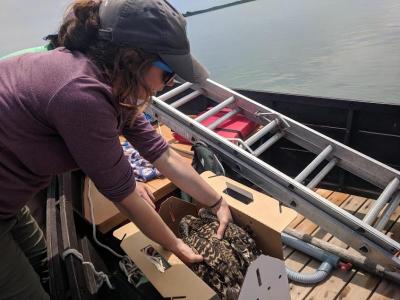Osprey ‘hacking’ brings birds to Illinois
Osprey are a treasured sign of spring in Wareham. But the osprey population was once dangerously low on the South Coast, and in other areas of the country, osprey are still endangered.
Katelyn Depot of the Mass Audubon Allens Pond Wildlife Sanctuary taught a crowd of osprey enthusiasts about the history of the species and current work to restore osprey populations in Illinois.
Land steward Mike Perrin of the Wareham Land Trust also announced the launch of a Wareham OspreyWatch program, which anyone can get involved in.
Osprey are birds of prey which hunt for fish in both salt and freshwater. They prefer to nest in open areas where they can see potential threats. Most often, the birds nest in trees or on man-made platforms built especially for osprey.
While osprey can live up to 25 years, a more typical lifespan is around ten years.
Osprey populations plummeted in the 1960s as the wide-spread use of insecticide DDT led to weakened eggs that often broke when the birds tried to incubate them.
When building platforms to serve as safe nesting places for osprey isn’t enough to rebuild their populations, conservationists turn to “hacking”: bringing young chicks from areas with high populations to areas with low populations.
In 2019, 12 six-week-old osprey were collected from nests on the Westport River and transported by plane to two locations in Illinois. There, they were placed in what are known as hack boxes. Hack boxes are artificial nests, located on platforms and filled with nesting material. The boxes are completely closed to protect the chicks from predators.
At six weeks old, osprey chicks are almost fully grown but not ready to fly.
Scientists closely monitor the chicks to determine when they are almost ready to fledge, or fly for the first time. When a chick is ready, it will begin to hop up and down and flap its wings.
When the chicks are ready to fledge, scientists open the door to the hack box during the day and close it at night to allow the chicks to learn to fly while keeping them safe.
They also continue to feed the chicks while they learn to hunt, which can take time.
Measuring the success of the program will take time, as osprey spend a full year in their wintering location after flying south for the first time, and don’t reproduce until they are three or four years old.
However, the first bird moved to Illinois as part of the hacking project returned last year and, with a mate, “adopted” two of the chicks transported from Westport, bringing them food each day.
Although the population of osprey in Wareham is healthy, the exact number of osprey around town is unknown.
The Wareham Land Trust is launching a new program to get community members involved in OspreyWatch, a citizen science project tracking the breeding activity of osprey.
All participants would need to do is find a nest and commit to spending thirty minutes watching it each week from March to October, and then submit information about what the osprey are doing to the OspreyWatch site. The data required is simple -- for example, one would note whether the osprey appear to be incubating eggs, or if there are chicks poking their heads out of the nest.
The Land Trust will be holding workshops to teach those interested how to observe the nests and enter the data online.
To learn more, email Land Steward Mike Perrin at stewardship@warehamlandtrust.org or go to osprey-watch.com.



.jpg)










